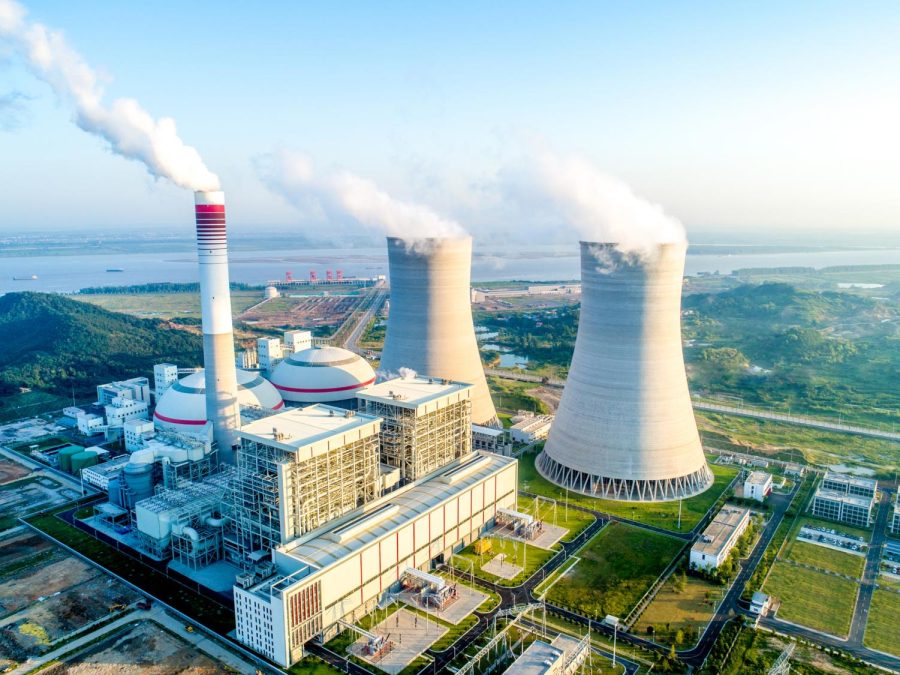Nuclear energy: A better source of power
Getty
The United States needs to pursue greater energy independence and the best way to do that is by pursuing nuclear energy as a primary source of power.
April 11, 2022
With gas prices being consistently above $4 per gallon, there is a desire to find a more consistent kind of energy. A source of power that won’t be as affected by global politics. The United States needs to pursue greater energy independence and the best way to do that is by pursuing nuclear energy as a primary source of power.
As of the end of 2020, there are currently 56 nuclear power plants in 28 states, including six in Illinois. Through the process of nuclear fission, splitting atoms, the energy that is released is used to heat water. The resulting steam spins turbines which generate the power from the plant, according to the Department of Energy.
THE BENEFITS
What’s remarkable about these plants is the amount of energy they can emit with the smallest of resources.
“A single cylinder of uranium equals three barrels of crude oil,” said Nicholas Pohlman, a mechanical engineering professor at Northern Illinois University.
In terms of greenhouse gas emissions, nuclear power is one of the best options, especially when the effects of climate change can be felt more with every passing year. During operation, no greenhouse gases are emitted from active nuclear power plants. Over its entire lifespan, nuclear power produces only 1.5% the carbon-dioxide emissions that coal does, according to the World Nuclear Association.
The efficiency of nuclear power plants is also worth noting. In 2020, nuclear energy had the highest capacity factor of any power source in America with 93%, according to The Department of Energy. This means that nuclear plants were generating their maximum amount of power 93% of the time during the year. That’s roughly 340 days of maximum energy.
Compared to 56.6% for natural gas and 40.2% for coal, nuclear energy continues to dominate in terms of power. Even renewable energy sources like wind and solar are only able to generate maximum capacity factors of 35.4% and 24.9% respectively, which makes sense. Due to how wind and solar generate power, each day is going to be inconsistent in terms of energy generated. Nuclear doesn’t share that distinction.
Nuclear energy currently generates 18.9% of our national power and roughly 50% of Illinois power, according to the Department of Energy. Illinois consumes more nuclear energy than any other state.
THE FLAWS
However, like all sources of energy, nuclear has its detractors. One of the biggest is the time it takes to create them.
“I can install solar panels in six months but a nuclear plant takes 10 to 15 years to make,” said Pohlman.
For communities seeking an easier way to attain renewable energy, solar and wind appear to be more logical. However, they have their problems. Wind turbines can last about 20 years and nuclear can last anywhere from 20 to 40. But nuclear energy generation is far more efficient.
One major problem that is associated with nuclear energy is the waste that is generated. Nuclear waste exists with some kinds being more dangerous than others and varying rates of sufficient decay, according to the EPA.
Currently, most of America’s nuclear waste is sitting in safe containers on-site but there have been efforts for a permanent disposal site in Yucca Mountain, Nevada, according to the Nuclear Energy Institute. However, the United States government hasn’t made a sufficient effort to create this site. Nuclear waste can be recycled to extract further energy — France does it quite well — but America currently doesn’t practice these methods.
And then there are the infamous disasters that make some people afraid of nuclear energy, most famously Three Mile Island in 1979, Chernobyl in 1986 and Fukushima in 2011. Chernobyl is the most egregious example because its meltdown was attributed to a flawed reactor design and the poorly handled attempts to cover up the accident.
However, in terms of overall safety, nuclear power is still among the safest forms of energy. It may not be the perfect form of energy but we need to make a change. We need a source that emits high amounts of energy with no greenhouse gasses. The American people also deserve efficient sources of energy that are produced on our own soil as opposed to countries with human rights violations like Saudi Arabia and Russia.
Even if we make individual choices towards renewable energy, such as hooking up our homes to solar and buying electric cars, we need to make a societal change to more efficient sources of energy. Toward what powers our cities. Toward what keeps America running.







